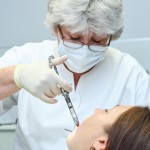
Inferior alveolar nerve block (IANB) is the standard technique to obtain pulpal anaesthesia for the mandibular molar teeth. However, in teeth with symptomatic irreversible pulpitis pulpal anaesthesia can be more difficult to achieve with failure rates between 43-83% being reported. A number of different anaesthetic techniques and supplemental injections have been considered to reduce anaesthetic failure including, buccal infiltration (BI), lingual infiltration (LI), intraligamentary injections (ILI), intraseptal injection (ISI) mental/incisive nerve block (MINB), Gow-Gates nerve block (GGNB), Vazirani-Akinosi nerve block (VANB).
The aim of this review was to assess which is the most effective method of anaesthesia for mandibular posterior teeth with symptomatic irreversible pulpitis.
Methods
Searches were conducted in the Cochrane Library, Embase, Lilacs, PubMed, Scopus, Web of Science ProQuest, OpenGrey, and Google Scholar databases with no restrictions on language or date of publication. Randomised controlled trials (RCTs) comparing the anaesthetic success rate of IANB and any other alternative anaesthetic technique were considered. Two reviewers independently screened and selected studies, extracted data and assess study quality using the Cochrane Risk of Bias 2.0 tool. Any conflicts were resolved by a third reviewer. The primary outcome measure was the effectiveness of the anaesthetic techniques (single techniques or combinations) in achieving successful anaesthesia. Random effects meta-analyses were conducted to find the pooled estimates of risk ratio (RR) with 95% confidence intervals (CI). Certainty of evidence was assessed using the Grading of Recommendations, Assessment, Development and Evaluation (GRADE) approach.
Results
- 22 studies involving a total of 1952 patients were included.
- 15 studies were considered to be at low risk of bias, 5 at unclear risk and 2 at high risk.
- 13 different techniques or combinations were tests as shown in the table.
| Techniques assessed | Number of studies | Techniques assessed | Number of studies |
| GGNB | 4 | ILI with BI and IANB | 1 |
| GGNB with IANB | 1 | ISI with BI and IANB | 1 |
| BI | 4 | VANB | 3 |
| BI with IANB | 5 | MINB | 2 |
| BI with LI | 1 | MINB with IANB | 1 |
| BI with LI and IANB | 1 | IOI | 1 |
| ILI with IANB | 1 |
- Meta-analyses of 6 techniques compared to inferior alveolar nerve block (IANB) was possible with buccal infiltration (BI) + IANB showing the most success.
| No. of studies | Risk Ratio (95%CI) | |
| Buccal infiltration (BI) + IANB | 5 | 1.88 (1.22 – 2.79) |
| Vazirani-Akinosi nerve block (VANB) | 3 | 1.27 (1.07 – 1.52) |
| Intraosseous injection (IOI) | 3 | 1.48 (1.02 – 2.15) |
| Gow-Gates nerve block (GGNB) | 4 | 1.21 (0.94 – 1.55) * |
| Buccal infiltration (BI) | 4 | 1.08 (0.93 – 1.26) * |
| Mental/incisive nerve block (MINB) | 2 | 1.15 (0.97 – 1.36) * |
* Not significant
- The certainty of the evidence was rated as very low to low using the GRADE approach.
Conclusions
The authors concluded: –
………… very low to low quality of evidence that suggest that VANB, IOI, and BI associated with IANB are more effective than IANB at anesthetizing posterior mandibular teeth with symptomatic irreversible pulpitis. Based on the findings of this systematic review, the effectiveness of GGNB, BI, and MINB does not differ from the IANB.
Comments
This review has searched a wide range of databases and followed the Preferred Reporting Items for Systematic Reviews and Meta-Analyses (PRISMA) guidelines. Obtaining pulpal anaesthesia in teeth with irreversible pulpitis can be challenging and supplemental injection techniques are often employed after the failure of the primary technique which may influence their effectiveness. Consequently, this review did not include clinical trials of supplemental or complementary anaesthesia techniques, applied after failure of primary anaesthesia. While 22 RCTs were identified they reported on 13 techniques or combinations of techniques so only a smaller number of studies was available for each technique. Meta-analyses was possible for 6 of the techniques which suggested better anaesthetic outcomes for 3 techniques, buccal infiltration (BI) + IANB, Vazirani-Akinosi nerve block (VANB) and intraosseous injection (IOI) . In addition to range of techniques assessed in the studies there was variation in the anaesthetic agents used with 2% lidocaine with different concentrations of epinephrine being used in 10 studies ,4% articaine in 5 studies, 3% mepivicaine in one studies and combinations of agents in other studies. While the reviewers have conducted a sensitivity analyses on the influence of the anaesthetic agents few studies are available to assess the impact on the various techniques. Overall, the evidence to support the various techniques is of very low to low certainty so the findings should be interpreted cautiously. Addition well conducted and reported studies should compare the various techniques using the same anaesthetic agents to assess whether differences are really due to variations in the anaesthetic technique, or the anaesthetic agents being used.
Links
Primary Paper
Dias-Junior LCL, Bezerra AP, Schuldt DPV, Kuntze MM, de Luca Canto G, da Fonseca Roberti Garcia L, da Silveira Teixeira C, Bortoluzzi EA. Effectiveness of different anesthetic methods for mandibular posterior teeth with symptomatic irreversible pulpitis: a systematic review and meta-analysis. Clin Oral Investig. 2021 Dec;25(12):6477-6500. doi: 10.1007/s00784-021-04145-7. Epub 2021 Aug 28. PMID: 34453595.
Other references
Dental Elf – 25th Feb 2020
Pulpal anaesthesia for symptomatic irreversible pulpitis in mandibular molars
Dental Elf – 1st Mar 2019
